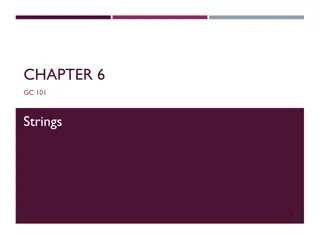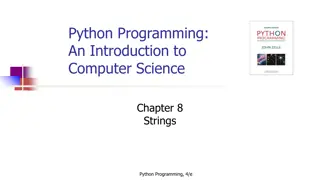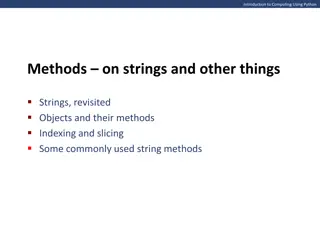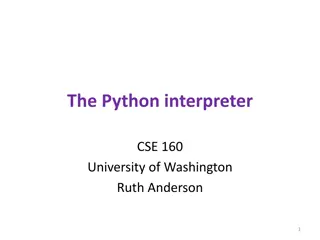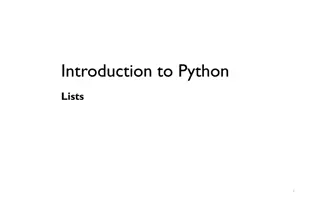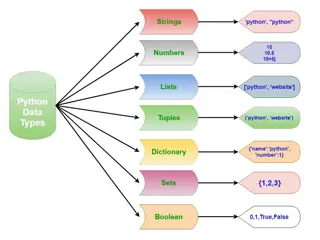Understanding String Indexing and Slicing in Python
Python strings are sequences of characters that can be accessed using indexing and slicing. Indexing allows you to access individual characters in a string using numerical positions, starting from 0. Slicing enables you to extract a portion of a string by specifying a range of indices. Understanding these fundamental string operations is essential for text-based computing tasks in Python.
Download Presentation

Please find below an Image/Link to download the presentation.
The content on the website is provided AS IS for your information and personal use only. It may not be sold, licensed, or shared on other websites without obtaining consent from the author. Download presentation by click this link. If you encounter any issues during the download, it is possible that the publisher has removed the file from their server.
E N D
Presentation Transcript
15-110: Principles of Computing Sequences- Part I (Strings) Lecture 11, October 11, 2018 Mohammad Hammoud Carnegie Mellon University in Qatar
Today Last Session: Quiz I Today s Session: Sequences- Part I (Strings): Basic String Operations String Representation String Methods Announcement: The midterm is on Thursday, October 18
Overview So far, we have seen how to define strings, get them as input, assign them to variables, and print them out Unfortunately, this is not quite enough to do any serious text-based computing! For this, we need some more string operations (which we know some already) and functions
Indexing Strings Recall that a string is a sequence of characters, which can be thought of as being stored in numbered buckets, starting from the left with 0 H E L L O 0 1 2 3 4 Individual characters that make up the string can then be accessed through the operation of indexing >>> s = "HELLO" >>> s[0] 'H' >>>
Indexing Strings Notice that in a string of n characters, the last character is at position n-1, because the indexes start at 0 H E L L O 0 1 2 3 4 >>> s = "HELLO" >>> s[4] 'O' >>> s[5] Traceback (most recent call last): File "<stdin>", line 1, in <module> IndexError: string index out of range >>> Accessing the bucket at position n (or more) will result in an IndexError
Indexing Strings We can also index a string from the right end using a negative number, after which Python will add the length of the string to the number and index the string at the resultant number (or position) -1 + 5 (i.e., the length of the string) = 4 -5 -4 -3 -2 -1 H E L L O 0 1 2 3 4 >>> s = "HELLO" >>> s[-1] 'O' >>> s[-5] 'H' >>>
Slicing Strings Aside from indexing, which returns a string containing a single character from a larger string, it is also possible to access a contiguous sequence of characters (or a substring) from a string In Python, this is accomplished through an operation called slicing, whichtakes the form <string>[<start>:<end>] start and end should be int-valued expressions Slicing returns the substring starting at start and running up to, but not including, end
Slicing Strings Examples: H E L L O W O R L D 0 1 2 3 5 6 4 7 8 10 9 >>> greet = "HELLO WORLD" >>> greet[0:5] 'HELLO' >>> greet[6:11] 'WORLD' >>> greet[:5] 'HELLO' 0 is assumed as the default if start is missing
Slicing Strings More examples: H E L L O W O R L D 0 1 2 3 5 6 4 7 8 10 9 Last position is assumed as the default if end is missing >>> greet[6:] 'WORLD' >>> greet[:] 'HELLO WORLD' >>>
Concatenating and Repeating Strings The string data type also supports concatenation (+) and repetition (*) operations for putting strings together Concatenation (which we ve seen before) builds a string by gluing two strings together Repetition builds a string by multiple concatenations of a string with itself >>> s1 = "Hello " >>> s2 = "World " >>> s3 = s1 + s2 >>> s3 'Hello World ' >>> s4 = s3 * 2 >>> s4 'Hello World Hello World ' >>>
Getting the Length and Iterating Over Strings Another useful function is len(), which tells how many characters are in a string As seen before, we can also iterate over the characters of a string greet = "Hello All" count = 0 while count < len(greet): print(greet[count], end = " ") count = count + 1
Getting the Length and Iterating Over Strings Another useful function is len(), which tells how many characters are in a string As seen before, we can also iterate over the characters of a string #The program continues here print() This for loop is equivalent to the earlier while loop for i in greet: print(i, end = " ") H e l l o A l l H e l l o A l l Output:
Summary of the Basic String Operations The following table summarizes the basic string operations Operator + * <string>[] <string>[ : ] len(<string>) for <var> in <string> Meaning Concatenation Repetition Indexing Slicing Length Iteration through characters
String Representation By now, you have started getting the hang of computing with textual (string) data But, how does a computer manipulate strings? Earlier in class, we discussed that numbers are stored in binary notation (i.e., sequence of zeros and ones) Textual information is represented exactly the same way! In particular, each character is translated into a number, and the entire string is stored as a sequence of (binary) numbers in computer memory What number is used to represent any given character?
String Representation It does not really matter what number is utilized to represent any given character as long as all types of computers use the same number Consider a situation that would result if, say, a Windows-based and a Linux-based computers each used its own numbers (or encoding) What happens if you type some strings in a text file using a Windows-based machine and send that file to someone who has a Linux-based machine? The file at the Linux-based machine will have different strings than the ones in the file at the Windows-based machine! How to avoid this problem?
String Representation Computer systems nowadays use industry standard encodings One important standard is called ASCII (American Standard Code for Information Interchange) ASCII uses the numbers 0 through 127 to represent the characters typically found on an (American) computer keyboard E.g., The capital letters A-Z are represented by the values 65-90, and the lower-case a-z characters are represented by the values 97-122
String Representation ASCII is American-centric What about other languages? Unicode is a much larger standard that includes support for the characters of nearly all written languages (ASCII is a subset of Unicode) Python uses Unicode and provides a couple of built-in functions that allow us to switch back and forth between characters and their corresponding Unicode numeric values The ord() function returns the numeric ( ordinal ) code of a single character The chr() function goes the other direction
String Representation Here are some interactive examples: >>> ord("a") 97 >>> ord("b") 98 >>> ord("z") 122 >>> ord("A") 65 >>> >>> ord("D") 68 >>> ord("Z") 90 >>> chr(90) 'Z' >>> chr(65) 'A' >>>
Strings Are Immutable Strings are immutable (i.e., cannot be changed after they are created) >>> mystr1 = "Python strings are immutable" >>> mystr1[0] = "X" Traceback (most recent call last): File "<stdin>", line 1, in <module> TypeError: 'str' object does not support item assignment >>> id(mystr1) 4362322688 >>> mystr1 = mystr1 + "!" >>> id(mystr1) 4362323008 >>> id() is a function that allows getting the memory address of any object Concatenating two strings generate a new string with a new memory address
String Methods Python has quite a few methods that string objects can call For example, the split() method can be utilized to split a string into a list (more on this next lecture) of substrings By default, split() will split the string wherever a space occurs >>> s1 = "Hello, string methods!" >>> s1.split() ['Hello,', 'string', 'methods!'] >>> Referred to as a list
String Methods The split() function can also be used to split a string at places other than spaces by supplying the character to split on as a parameter For instance, if we have a string of numbers separated by commas, we could split on the commas as follows: >>> "32,24,25,57".split(",") ['32', '24', '25', '57'] >>> "32,24,25,57".split() ['32,24,25,57'] >>>
String Methods In general, the split() function has the following syntax: split(Separator, Maxsplit) Where: Separator is the delimiter at which the string is split at (if it is not provided, white space will the separator) Maxsplit is the number of splits that shall be performed on the string (if it is not provided, there will be no limit on the number of splits)
String Methods Here are some interactive examples: >>> mystr1 = "topic: string methods" >>> mystr1.split(": ") ['topic', 'string methods'] >>> mystr2 = mystr1 + ": October, 2018" >>> mystr2.split(": ") ['topic', 'string methods', 'October, 2018'] >>> >>> mystr2.split(": ", 0) ['topic: string methods: October, 2018'] >>> mystr2.split(": ", 1) ['topic', 'string methods: October, 2018'] >>> mystr2.split(": ", 2) ['topic', 'string methods', 'October, 2018'] >>>
Some Other String Methods Function Meaning s.capitalize() s.center(width) Copy of s with only the first character capitalized Copy of s centered in a field of given width s.count(sub) Count the number of occurrences of sub in s s.find(sub) s.ljust(width) Find the first position where sub occurs in s Like center, but s is left-justified s.lower() Copy of s in all lowercase characters s.lstrip() Copy of s with leading white space removed
Some Other String Methods Function Meaning s.replace(oldsub, newsub) s.rfind(sub) Replace all occurences of oldsub in s with newsub Like find, but returns the rightmost position s.rjust(width) Like center, but s is right-justified s.rstrip() s.title() Copy of s with trailing white space removed Copy of s with first character of each word capitalized s.upper() Copy of s with all characters converted to uppercase
Next Lecture Lists


